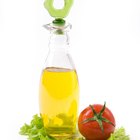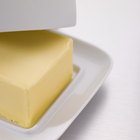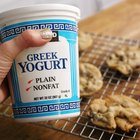More Articles

Mild tasting canola oil is produced from rapeseed, a member of the mustard family, along with broccoli and cabbage. Lard, made from pork fat, varies from strong tasting types to those processed with milder flavors, such as leaf lard taken from the fat around the pig's kidney. You can use either lard or canola oil in baking, but there are trade-offs with each fat, and certain foods that do well with one or the other type of fat.
Pastry
Because lard contains more saturated fat molecules than canola oil, the molecules retain their solid state when they are rolled into a pastry dough. The fat remains solid, coating each particle of flour instead of merging with the flour and causing a sticky gluten to form, as is the case with oil. The solid fat and flour create layers within the dough. When the layers hit the heat of the oven, the fat melts, steam is trapped in the empty space, and flaky pastry results.
Cakes
Whether you use canola oil or lard for a cake depends on what kind of cake you want. Solid fats, such as lard or butter, are better at holding the air bubbles in the cake batter, leading to more airy cakes. Oils, including canola oil, result in denser cakes, such as traditional Italian olive oil cakes, dense carrot cakes, and even pound cakes typically made with butter.
Cookies
Although unusual, some cookies rely on either lard or oil instead of butter. In countries where people use lard for traditional recipes, you'll also find lard in cookies. In Mexico for example, Day of the Dead raisin and nut cookies rely on lard. Cookies made with oil are typically more cake-like than other cookies -- their texture is more airy and light rather than dense and chewy even though they still have the shape and size of cookies.
Fats
If you want to lighten up the amount of saturated fat in your diet, you'll choose canola oil over lard despite its baking drawbacks. Canola oil and lard are as far apart as they can be in the amount of the saturated fat they contain, with canola oil having the least amount of all common oils at 6 percent, lard having 39 percent. Canola oil also has more healthy monounsaturated fat, with 62 percent compared to lard's 45 percent.
Related Articles

Can You Substitute Yogurt for ...

What Are Good Substitutes for Vegetable ...

What Can Be Used to Substitute for ...

Can You Substitute Shortening for ...

How Much Melted Shortening Do I Use in ...

Butter Substitute for Baking Scones
The Chemistry of Baking Brownies

Substitutes for Groundnut Oil in Cooking

What Happens if You Substitute Butter ...

Can You Substitute Vegetable Shortening ...

Butter Substitute for Molten Lava Cake

Substitution for Oil in Baking Brownies

Can I Substitute Bleached for ...

Does Canola Oil Taste the Same as ...

How to Make Your Own Hand Lotion With ...

What Kind of Oil Do You Use in Brownie ...

How to Replace Butter With Greek Yogurt ...

Cake Mix Alternative for Oil

How to Use Emu Oil on Hair
How to Substitute Yogurt for Oil
References
- The Deluxe Food Lover's Companion; Sharon Tyler Herbst and Ron Herbst
- The Science of Good Cooking; Editors at America's Test Kitchen and Gus Crosby
- Science Buddies: Perfecting Pastries: The Role of Fats in Making a Delicious Pastry
- The Cook's Thesaurus: Fats
- Saveur: Raisin and Nut Cookies
Writer Bio
Susan Lundman began writing about her love of cooking, ingredient choices, menu planning and healthy eating after working for 20 years on children's issues at a nonprofit organization. She has written about food online professionally for ten years on numerous websites, and has provided family and friends with homemade recipes and stories about culinary adventures. Lundman received her M.A. from Stanford University.
Photo Credits
Stockbyte/Stockbyte/Getty Images